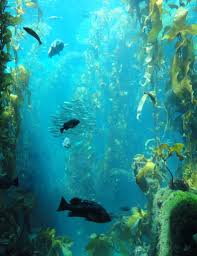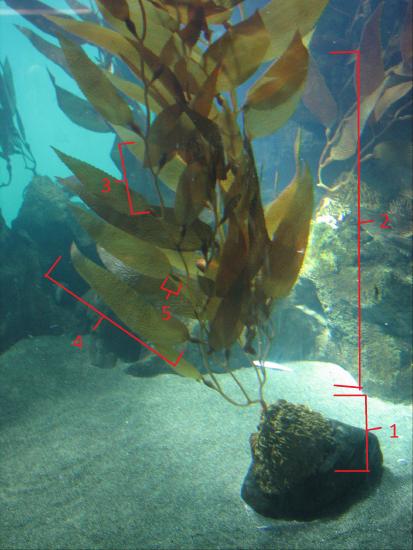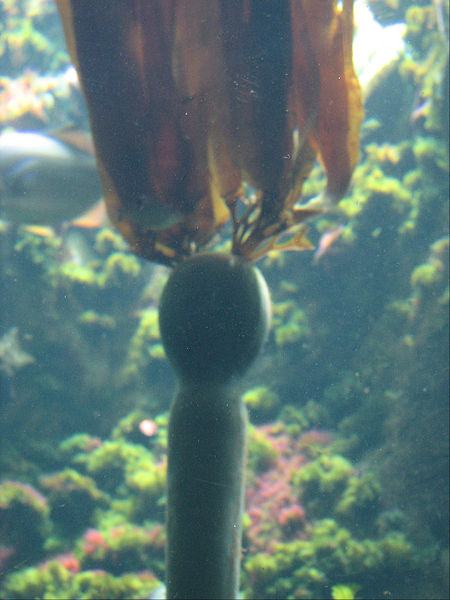77 11.5 Kelp Forest Ecosystems

Figure 1. depicts a kelp forest ecosystem commons.wikimedia.org/wiki/F…-_DSC06945.JPG
12.5.1 – Distribution
Kelp forests are mostly found in cool, shallow, nutrient-rich water near coasts. Kelp is a brown alga (Phaeophyceae), which requires access to light in order to photosynthesize – this is the reason for their abundance in shallow coastal waters (Sanctuaries.noaa.gov 2015). Kelp is one of the fastest growing organisms in the world, growing anywhere from 2 centimeter to 1 meter each day, depending on species and environmental conditions (Montereybayaquarium.org 2015).
Kelp can be found on the coast of every continent besides Antarctica (Figure 1). Kelp forest ranges include areas of cold water, generally coinciding with coastal upwelling (Sanctuaries.noaa.gov 2015). The eastern Pacific Ocean along the west coast of North America, is an ideal area for kelp forests due to the presence of upwelling bringing cold water and nutrients to the surface from deep ocean water. Towards the poles, kelp forest development is limited by the availability of light at higher latitudes, while kelp towards the equator tends to be limited by the presence of warmer waters (Steneck et al. 2002).
12.5.2 – Characteristics
Kelp forests often draw comparisons to terrestrial forests, however the two ecosystems are distinct in that kelp is an algae – not a member of the Plant Kingdom. The structure of all kelp bears three universal morphological characteristics: holdfasts, stipes, and fronds (figure 2).

Figure 2. Diagram of kelp anatomy. Labels characteristics found in many species of kelp; 1. Holdfast 2. Frond 3. Stipe 4. Blade 5. Gas bladder. Note that gas bladders are not present in all species of kelp. upload.wikimedia.org/wikiped…rocystis_4.JPG
The holdfasts, which serve as an anchor for kelp, must be attached to hard substrates such as rocks or sand. Although they resemble roots on terrestrial plants, holdfasts do not transport water or nutrients through their stipe. The stipe, analogous to the stem, gives structural support to the algae. Fronds are blades extending from the stipe. The blades serve as the photosynthetic and nutrient uptake center for the organism (Connor and Baxter 1989).

Figure 3. Pictured above is bull kelp. The single pneumatocyst is clearly shown at the end of the stipe, with fronds extending from the end.
commons.wikimedia.org/wiki/F…eocystis_2.JPG
In addition to the universal characteristics of all kelp, many species have also developed pneumatocyst – also known as a “gas bladder” . Pneumatocysts are gas-filled bladders that provide the kelp with buoyancy that lifts the blades towards the surface, allowing for more photosynthetic productivity. The most common species of kelp found in Pacific forests are giant kelp (Macrocystis pyrifera) and bull kelp (Nereocystis luetkeana), both of which contain pneumatocysts.
Giant kelp is common in southern areas of the coast and bull kelp in the northern. The reason for this schism is due to giant kelp being perennial, meaning that the same organism will grow for multiple years – in this case, up to seven years – while bull kelp is an annual, which means it will complete its entire life cycle in one year. Winter storms farther north rip up kelp, washing it onto the shore, which makes bull kelp, and its one-year life cycle, much better suited to northern areas.
12.5.3 – Ecology
12.5.3a – Habitat
Kelp forests are an important foundation species , which provide large areas of habitat within the ocean (Oceanservice.noaa.gov 2015). Kelp forests have a wide variety of inhabitants within their boundaries: invertebrates frequently graze on the blades, fish find shelter in the fronds, and invertebrates – such as brittle stars, sea stars, anemones, sponges and tunicates – live in the holdfast (Connor and Baxter 1989). Kelp is also the single largest source of fixed carbon within their ecosystems (Graham 2004). Pieces of decomposing kelp sink deeper into the ocean, providing nutrients to deep sea organisms. Thus, kelp derived particulate organic matter (POM) is an important food source for fauna both within and outside the kelp forest (Norderhaug et al., 2003).
Since kelp is capable of attenuating waves and dampening their energy, many animals, such as mammals and birds, are able to seek refuge in the forests (Mork 1994). Various species of kelp tolerate ocean storms differently (Montereybay.noaa.gov 2015). In fact, along the California coast giant kelp has been known to dominate in years with less turbulent sea conditions, while bull kelp is more dominant in open waters and years of turbulent conditions (Harrold et al., 1988).
12.5.3b – Sea Otters and Urchin Barrens
Sea otter (Enhydra lutris) are one of the keystone species within kelp forests – meaning that they have a substantial impact within an ecosystem despite their relatively small population. Otters’ diets consist mainly of invertebrates such as purple sea urchins (Strongylocentrotus purpuratus) which inhabit kelp forests along North America’s west coast. Urchins feed on kelp and can potentially damage kelp forests by chewing through kelp holdfasts. Otters are the primary predator of urchins, keeping their populations at sustainable levels and maintaining the ecological balance of the kelp forest. Without otters a trophic cascade can occur; leading to destructive levels of grazing by urchin, causing a phenomenon known as an “urchin barren” (Sala et al., 1998, Siversten 2006). Due to kelp’s role as a foundation species, significant populations of organisms that depend on their habitat are negatively impacted (Dayton 1985).
Fore more information:
Giant Kelp:
www.montereybayaquarium.org/a…ae/giant-kelp/
Bull Kelp:
www.montereybayaquarium.org/a…gae/bull-kelp/
Urchin Barren:
http://www.hindawi.com/journals/jmb/2012/492308/
Kelp Forests:
http://oceanservice.noaa.gov/facts/kelplives.html
sanctuaries.noaa.gov/about/ec…/kelpdesc.html
Kelp Forest Ecosystems:
References
Connor, J., and C. Baxter. 1989. Kelp forests, Monterey Bay Aquarium Foundation.
Dayton, P.K. 1985. Ecology of kelp communities. Annual Review of Ecology and Systematics 16: 215-245.
Graham, M.H. 2004. Effects of local deforestation on the diversity and structure of Southern California giant kelp forest food webs. Ecosystems 7: 341-357.
Harrold, C., Watanabe, J., Lisin, S. 1988. Spatial variation in the structure of kelp forest communities along a wave exposure gradient. Marine Ecology 9: 131-156
Montereybayaquarium.org,. 2015. Bull kelp, Kelp Forest, Plants & algae, Nereocystis luetkeana at the Monterey Bay Aquarium.
Montereybay.noaa.gov,. 2015. MBNMS Site Characterization: Kelp Forest and Rocky Subtidal Habitats – I. Kelp Forest Distribution and Ecology.
Mork, M. 1994. The effect of kelp in wave dampening. Sarsia 80: 323-327
Norderhaug, K.M., Fredriksen, S., Nydaard, K. 2003. Trophic importance of Laminaria hyperborea to kelp forest consumers and the importance of bacterial degradation to food quality. Marine Ecology Progress Series 255: 135-144.
Oceanservice.noaa.gov,. 2015. What lives in a kelp forest.
Sala, E., C.F. Boudouresque and M. Harmelin-Vivien. 1998. Fishing, trophic cascades, and the structure of algal assemblages: evaluation of an old but untested paradigm. Oikos 82: 425-439.
Sanctuaries.noaa.gov,. 2015. Kelp Description.
Sivertsen, K. 2006. Overgrazing of kelp beds along the coast of Norway. Journal of Applied Phycology 18: 599-610.
Steneck, R., M. Graham, B. Bourque, D. Corbett, J. Erlandson, J. Estes, and M. Tegner. 2002. Kelp forest ecosystems: biodiversity, stability, resilience and future. Envir. Conserv. 29, doi:10.1017/s0376892902000322
Stewart, N., and B. Konar. 2012. Kelp Forests versus Urchin Barrens: Alternate Stable States and Their Effect on Sea Otter Prey Quality in the Aleutian Islands. Journal of Marine Biology 2012: 1-12.
By Hill et al. (University of California, Davis), used under a CC-BY-NC-SA 4.0 international license. Download this book for free at https://geo.libretexts.org/Bookshelves/Oceanography/Book%3A_Oceanography_(Hill)

